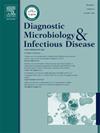粪便和尿液样本SAT-TB对肠和尿结核的诊断价值。
IF 2.1
4区 医学
Q3 INFECTIOUS DISEASES
Diagnostic microbiology and infectious disease
Pub Date : 2024-12-26
DOI:10.1016/j.diagmicrobio.2024.116672
引用次数: 0
摘要
背景:SAT-TB (simultaneous amplification/testing for tuberculosis)是一种针对特定16s rRNA的实时检测结核分枝杆菌的方法。目的:评价SAT-TB利用粪便和尿液样本检测肠道和尿路结核的性能。方法:于2021 - 2022年收集疑似肺合并肠或尿结核患者的粪便(94份)和尿液(69份)。采用SAT-TB法、Xpert MTB/RIF法和MGIT960培养法同时检测结核分枝杆菌。结果:粪便标本SAT-TB的灵敏度、特异度和曲线下面积(AUC)分别为53.33%、93.88%和0.736;Xpert分别为60%、81.63%和0.708;MGIT960分别为40%、95.92%和0.680。对于尿液样本,SAT-TB、Xpert和MGIT960的灵敏度、特异度和AUC分别为27.27%、98.28%和0.628;54.55%, 96.35%, 0.755;45.45%, 100%, 0.727。结论:ROC分析表明SAT-TB在单独检测粪便样本时具有最高的诊断效能。本文章由计算机程序翻译,如有差异,请以英文原文为准。
Diagnostic value of SAT-TB in stool and urine samples for intestinal and urinary tuberculosis
Background
The simultaneous amplification/testing for tuberculosis (SAT-TB) targets specific 16s rRNA for detecting Mycobacterium tuberculosis in real-time.
Objective
To evaluate SAT-TB's performance in detecting intestinal and urinary TB using stool and urine samples.
Methods
Stool (94) and urine samples (69) (From 2021 to 2022), were collected from pulmonary combined with suspected intestinal or urinary tuberculosis. Simultaneous detection of Mycobacterium tuberculosis was performed using the SAT-TB method, Xpert MTB/RIF assay, and MGIT960 culture.
Results
For stool samples, the sensitivity, specificity, and area under the curve (AUC) were 53.33 %, 93.88 %, and 0.736 for SAT-TB; 60 %, 81.63 %, and 0.708 for Xpert; and 40 %, 95.92 %, and 0.680 for MGIT960. For urine samples, the sensitivity, specificity, and AUC for SAT-TB, Xpert, and MGIT960 were 27.27 %, 98.28 %, 0.628; 54.55 %, 96.35 %, 0.755; and 45.45 %, 100 %, 0.727, respectively.
Conclusion
ROC analysis indicated that SAT-TB had the highest diagnostic efficacy for stool samples when tested individually.
求助全文
通过发布文献求助,成功后即可免费获取论文全文。
去求助
来源期刊
CiteScore
5.30
自引率
3.40%
发文量
149
审稿时长
56 days
期刊介绍:
Diagnostic Microbiology and Infectious Disease keeps you informed of the latest developments in clinical microbiology and the diagnosis and treatment of infectious diseases. Packed with rigorously peer-reviewed articles and studies in bacteriology, immunology, immunoserology, infectious diseases, mycology, parasitology, and virology, the journal examines new procedures, unusual cases, controversial issues, and important new literature. Diagnostic Microbiology and Infectious Disease distinguished independent editorial board, consisting of experts from many medical specialties, ensures you extensive and authoritative coverage.

 求助内容:
求助内容: 应助结果提醒方式:
应助结果提醒方式:


